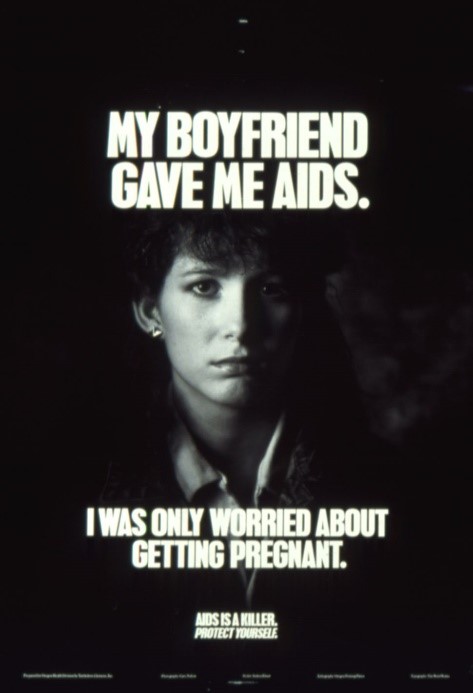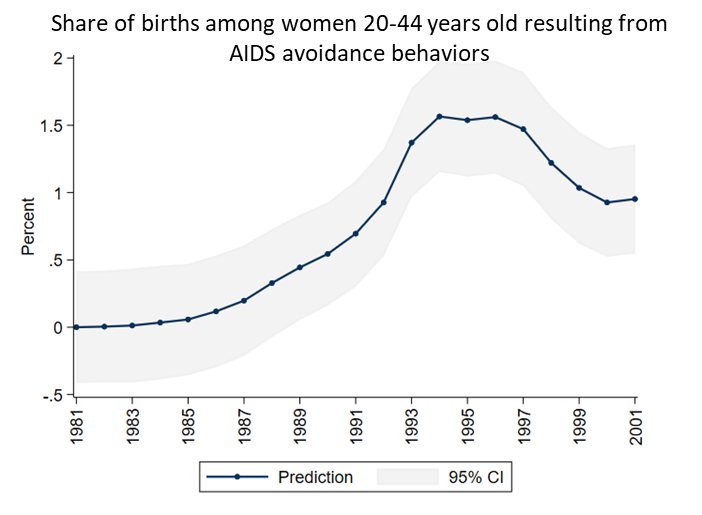Safer Sex? The Effect of AIDS Risk on Birth Rates
2 Min Video: https://bit.ly/3iTqFej
Paper:">https://bit.ly/3iTqFej&q... https://melissakspencer.com/SaferSex.pdf
Thread:">https://melissakspencer.com/SaferSex....
Do STI avoidance behaviors affect birth rates? I investigate this question by studying the spread of AIDS across U.S. cities in the 1980s and 1990s. I find that birth rates increase (?!) in response to AIDS risk. Keep reading to find out why. 1/N
People can mitigate the risks of STI & pregnancy by adjusting sexual behavior & contraception, but there are trade-offs (i.e. condoms protect from STI but have high failure rate with pregnancy). So, increases in the risk of STI could affect birth rates. This is what I study! 2/N
I analyze the spread of AIDS across U.S. cities in the 1980s and 1990s, which is plausibly exogenous w.r.t. women’s sexual behavior (due to 10-year average incubation period, and spread largely driven by men with same-sex partners during early years of pandemic). 3/N
AIDS also created a large shock to the cost of contracting an STI, so it’s reasonable to think women would adjust sexual behavior, even if it meant increased risk of pregnancy. Poster from Oregon department of health in 1986 illustrating the joint risk of pregnancy and AIDS  https://abs.twimg.com/emoji/v2/... draggable="false" alt="⬇️" title="Pfeil nach unten" aria-label="Emoji: Pfeil nach unten">4/N
https://abs.twimg.com/emoji/v2/... draggable="false" alt="⬇️" title="Pfeil nach unten" aria-label="Emoji: Pfeil nach unten">4/N
I use data on city-level birth rates and AIDS incidence among women (my measure of AIDS risk) from 1981 to 2001. Results from fixed effects specification with controls for city and year show that AIDS risk led to an increase in birth rates among women aged 20-44. 5/N
I find that birth rates increased by as much as 1.5% due to AIDS avoidance behaviors. This result is robust to weighting, to the inclusion of city-specific trends, and to controls for poverty, marriage rates, Medicaid, drug use, prostitution, education, & incarceration. 6/N
We might think that changing attitudes towards sex is driving increases in AIDS & births. I find that only AIDS among women & heterosexual men (and not homosexual men or bisexual men) increases births. Women responded to their true risk of AIDS, not the AIDS epidemic overall. 7/N
I also find that incidence of gonorrhea among women goes down in response to AIDS risk. Women are successfully adopting behaviors that protect themselves from AIDS and other STIs, but at the cost of higher pregnancy chance. 8/N
What could cause gonorrhea to decrease but births to increase? Women can switch from more effective contraceptives to condoms, or women can enter monogamous partnerships (1 partner = lower STI risk, but higher pregnancy risk if unprotected sex more frequent). 9/N
Evidence that women responded to AIDS with monogamy:
1) Increase in births is driven by cohabiting women.
2) Survey results show that 16% of unmarried women responded to AIDS by choosing to have sex with only one man (also the most common behavior reported). 10/N
1) Increase in births is driven by cohabiting women.
2) Survey results show that 16% of unmarried women responded to AIDS by choosing to have sex with only one man (also the most common behavior reported). 10/N
An unintended consequence of AIDS avoidance behaviors is an increase in birth rates. Women responding to increases in AIDS risk with monogamy are more likely to have a child. Why does this matter? 1)Screening at-risk patients & 2)Policy response to drug-resistant gonorrhea. 11/N
When health providers screen patients for risk factors, having only 1 sexual partner is viewed as an indicator for low risk of STI. My results suggest these women are actually at higher risk of pregnancy and should be targeted for discussions of more effective contraception. 12/N
We are rapidly running out of treatment options for drug-resistant gonorrhea. Check out this scary video: https://bit.ly/3jQyent ">https://bit.ly/3jQyent&q... My research shows how women might adjust behavior in response to drug-resistant STIs & can inform public health interventions to combat disease. 13/N
Thanks for reading this thread about my JMP! I welcome all feedback and questions! 14/N

 Read on Twitter
Read on Twitter 4/N" title="AIDS also created a large shock to the cost of contracting an STI, so it’s reasonable to think women would adjust sexual behavior, even if it meant increased risk of pregnancy. Poster from Oregon department of health in 1986 illustrating the joint risk of pregnancy and AIDS https://abs.twimg.com/emoji/v2/... draggable="false" alt="⬇️" title="Pfeil nach unten" aria-label="Emoji: Pfeil nach unten">4/N" class="img-responsive" style="max-width:100%;"/>
4/N" title="AIDS also created a large shock to the cost of contracting an STI, so it’s reasonable to think women would adjust sexual behavior, even if it meant increased risk of pregnancy. Poster from Oregon department of health in 1986 illustrating the joint risk of pregnancy and AIDS https://abs.twimg.com/emoji/v2/... draggable="false" alt="⬇️" title="Pfeil nach unten" aria-label="Emoji: Pfeil nach unten">4/N" class="img-responsive" style="max-width:100%;"/>



